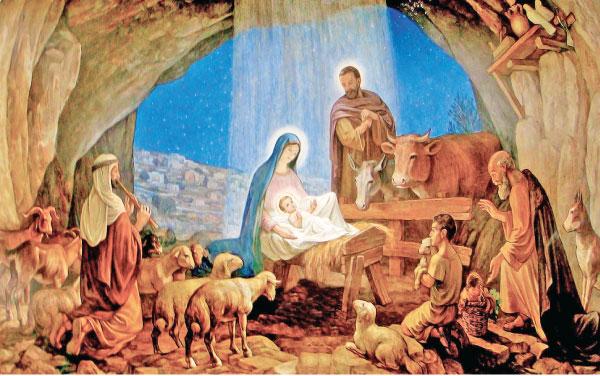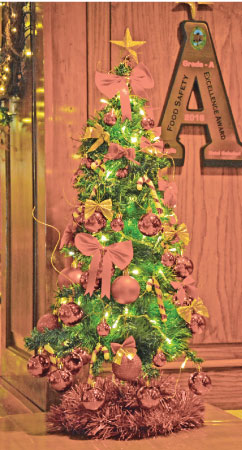
People celebrate Christmas as it is the birth of Jesus Christ. There are many traditions associated with Christmas. Let us look at a few of them.
Nativity plays and cribs
Nativity plays are held by churches, schools, Sunday Schools and many other groups the world over during the Christmas Season. The word nativity is derived from the Latin word Natal, meaning birth.
In a Nativity play, the birth of Christ is acted out as well as the visits of the shepherds and the three wisemen.
The first Nativity play was acted in 1223 by St. Francis of Assisi and his followers in a cave in Italy. St. Francis used wooden figures to depict the characters and told the part of each character himself. After about two years, the play became very popular and people began to act and sing songs in them. These songs are what we call Christmas Carols.
Churches and homes have cribs in them as a reminder of who Christ was and what he is to us. Some of these cribs have life size figures. Some cribs are made early but the figure of the Baby Jesus is only placed in the crib at midnight.
The crib is the most important Christmas decoration in certain countries, including Italy, Malta and many South American countries. The Italian city Naples, has been using cribs as decorations in churches and homes from the 1020s. Naples is also home to the world’s biggest crib which is in the Museo Nazionale di S. Martino. It has 162 people, 80 animals, angels and around 450 other smaller pieces.
Festival of Nine Lessons and Carols
Today, many schools and churches have a Festival or a Service of Nine Lessons and Carols during the Christmas Season. It is generally held on the first Sunday in December. Originally, it was held on Christmas eve and some places still have it then. This service has Nine Bible Readings or Lessons with one or two carols in between.
The creator of this service was Edward Benson, Bishop of Truro in Cornwall, UK, and it was first performed in 1880. It was held at 10.00 p.m.on Christmas eve in a large wooden building being used as a temporary Cathedral, while the Cathedral of Truro was being rebuilt.
The service soon became popular in the UK and elsewhere. The Festival of Nine lessons and Carols at King’s College, Cambridge is famed the world over and is held on Christmas eve at 3 pm UK time. BBC Radio broadcasts this service.
It was first performed at King’s College in 1918 to celebrate the end of the war. The then Dean of the College Eric Milner – White changed the opening hymn to Once in Royal David’s City in 1919 and set the main order and structure for the Festival of Nine Lessons and Carols. This order and structure is still followed today.
Christmas trees
The tree that is traditionally used as a Christmas tree is the evergreen tree or the Fir tree. It was used even before Christian times for pagan winter festivals like the Winter Soltice.
No one is sure when Fir trees were first used as Christmas trees. It is thought that the custom originated in Northern Europe hundreds of years ago. Two European cities claim to have had the first documented Christmas tree. One is the City of Tallinn in Estonia (1444) and the other is Riga, the capital of Latvia (1510). Both trees were put up by the Brotherhood of Black Heads – an association of unmarried merchants, ship owners and foreigners living in Livonia (a combination of Estonia and Latvia then). It is said that Brotherhood members danced around them and then set them on fire. In Riga’s town square, there is a plaque with the engraving The First New Year's Tree in Riga in 1510, in eight languages.
The first person to bring a Christmas tree into a home may have been Martin Luther King, the German preacher in the 16 century. He had been walking through a forest and looking up had seen stars glitter in the night sky through the branches of trees. It was a beautiful sight that he went home and told his children that it reminded him of Jesus who left the stars of Heaven to come to earth at Christmas.
Another legend says that St. Boniface of Crediton left England and went to Germany to preach to the pagan tribes there to convert them to Christianity. He came upon some pagans worshipping an oak tree and preparing to sacrifice a young boy. A very angry St. Boniface cut down the tree and a fir tree sprang from the oak’s roots. The saint took this as a sign of Christian faith and his followers fixed lit candles to the fir tree so St. Boniface could preach to the pagans at night.
There is also a German legend which says how a forester’s family befriended a lost and lonely boy who appeared on their doorstep one cold winter’s night. The next day, they woke to the sound of a choir of angels singing and the boy had turned out to be Jesus Christ. He had broken a fir branch and given it to the family as a thank you gift for looking after him. So, ever since that day, people remember what happened that night.
